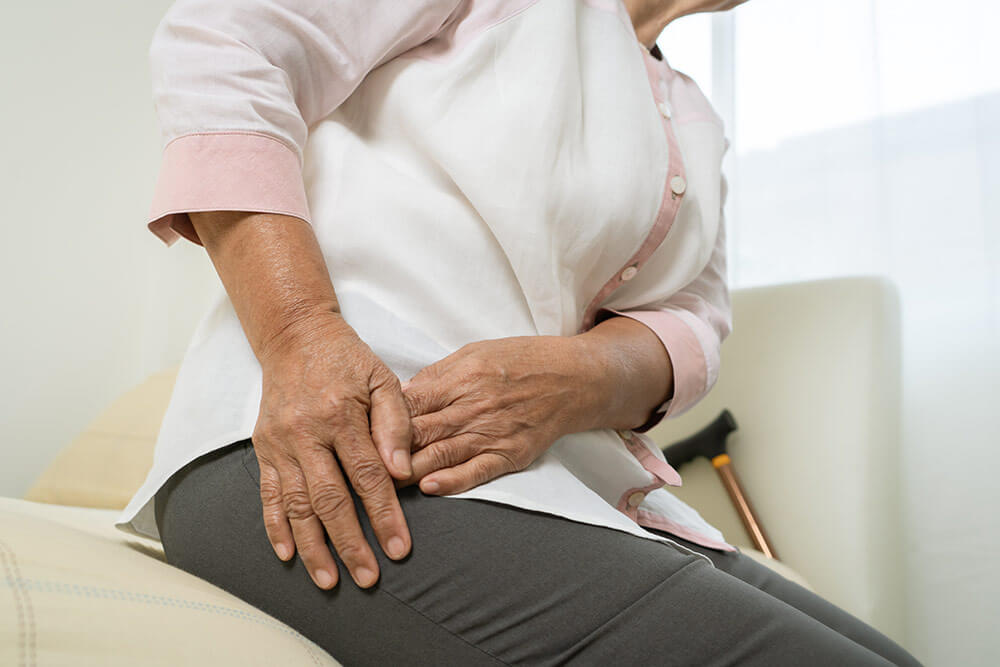Hip fracture: types, symptoms and complications. Hip fracture in the older adults is one of the most common causes of their morbidity and mortality and thus a common trigger to hire a carer.
As a consequence of the fracture, our elder suffers a triple aggression: the fall itself, the subsequent surgery and the worsening of the chronic diseases he already suffered.
In order to know this frequent reality that many senior citizen have to face, the Nomenial team explain it in depth in these lines:
Femur and hip fracture in the older adults
Most hip fractures occur in one of the two parts of the femur, the femoral neck (top of the femur) and the intertrochanteric region (below the hip joint itself). In fact, a hip fracture is actually a break in the neck of the femur.
Types of hip fractures, classification
Hip fractures can be classified according to the location of the body where it has occurred. Thus, there are three zones, among which the most common in older people is zone 1, specifically the type of subcapital hip fracture.
Subcapital hip fracture
These are those that occur just below the femoral head.
They generally have a traumatic origin and can be with or without displacement.
These are the type of fractures that occur, more commonly, among women and people over 60 years.
Subcapital fractures are in turn subdivided, using the Garden classification, into several types according to their level of severity:
- Type I: incomplete fracture, also called “valgus” fracture. It can be displaced if it is not contained by adequate treatment.
- Type II: complete fracture but without displacement. As in the previous case, secondary displacement may occur if not treated.
- Type III: complete fracture with partial displacement. This is the most frequent fracture of the hip.
- Type IV: complete fracture with total displacement. The head of the femur and the femoral neck are completely unlinked.
- Subcapital hip fracture treatment: the most common choice to treat this type of hip fracture is by implanting a hip prosthesis.
Hip fracture symptoms
The main symptoms of hip fracture are
- Intense pain in the hip.
- Loss of mobility in the joint
- The leg in which the fracture has taken place suffers deformation.
- Sensitivity and swelling in the affected area.
- Hematomas.
Hip fracture: types, symptoms and complications: Diagnosis of hip fracture
Almost all cases of hip fracture are diagnosed from a doctor’s visit in which the older person is notified that he or she has suffered a fall and feels intense pain in the hip area, as well as the inability to walk. Simple x-rays will determine the exact diagnosis.
Thus, the physician will determine whether the hip fracture exists by analyzing the symptoms and by ascertaining that the hip and leg are in an abnormal position.
Treatment of the hip fracture
Due to the risk of suffering the above-mentioned complications in case the fracture is not operated, in almost all cases, the doctor will decide to perform surgery during the first hours.
With regard to the fear of fractured hip prostheses, it should be noted that in recent years, surgery has advanced enormously, so that rejection or breakage of the prosthesis occurs in less than 3% of cases.
After the operation, our major will have to follow the prescribed treatment, in which a fundamental part will be the rehabilitation.
Rehabilitation hip fracture
From the first day after surgery, the medical team will make our family member walk to avoid spending too much time in bed. Initially, through physical therapy he will work to improve range of motion and increase strength.
It is of great importance to emphasize here that when the person leaves the hospital after the operation, he or she will need permanent care that will provide him or her with good care. It is at this time that the figure of the professional caregiver will be of great value. Given her experience in the care of the older adults and in the attention of the pathologies and ailments that they most commonly suffer (such as hip fractures), her care will improve the quality of life of our older adults and increase their possibilities of recovery.
Non-operated hip fracture
If the hip fracture is not operated on, the patient will be condemned to be immobilized and bedded for a very long period of time. Due to this prolonged situation, our elder will be more exposed to suffer complications derived from physical, infectious and pulmonary character, as well as, of course, a greater risk of early mortality.
In this way, not receiving adequate surgical treatment will include a series of complications that are explained in the following point.
Hip fracture complications
Thus, patients with a hip fracture may suffer various complications in the days following the fracture. Among the most prominent are the following:
- Deep vein or pulmonary thrombosis The null mobility of the leg after the fracture or the surgical intervention can trigger the application of a thrombosis of the veins of the leg. These thromboses can ascend to the lung. Therefore, if our older person has suffered a hip fracture, he will most likely be treated with anticoagulants (usually heparin).
- Ulcers. As a result of the bedding that patients must undergo, they are more likely to develop pressure ulcers on their back or ankles.
- Disorientation and confusion.
- Pneumonia.
- Worsening of the physical condition, as muscle tissue decreases.
- Loss of autonomy, becoming totally dependent.
- Consequence of all the above: depressive state and social isolation.
Hip fracture: types, symptoms and complications: Survival after hip fracture
The hip fracture is an event with serious consequences in a great majority of cases.
Due to it, the patient suffers physical, mental, functional and social damage, so that his life expectancy decreases considerably.
Thus, the mortality rate after suffering a hip fracture doubles that of people of the same age without a fracture. However, the cause of death is not the hip fracture itself, but the systemic diseases that the older adults already suffer, so the consequences of the fracture will depend directly on their own state of health.
Factors to take into account:
- Age – Hip fracture due to fall. As age advances, the risk of suffering from falls of considerable severity increases. In fact, 1 in 5 falls of people over 65 years cause serious injuries. Among the most common is a broken hip.
- Bone density and muscle mass decrease as we age, along with loss of vision and balance, increasing the risk of falling.
- Sex. Hip fractures are mostly suffered by women. They represent, specifically, 70% of the cases. This is because women lose bone density more quickly than men, so their stability and strength is less.
- Chronic medical disorders. There are various disorders that our elders have in a chronic way whose most outstanding effects are the decrease in bone density, as well as the increase in bone weakness. In this case, it is important to point out that within these disorders we also find those related to the cognitive system (such as, for example, Parkinson’s, dementia or strokes).
- Some medications. The prolonged intake of certain medications causes bone deterioration. Among the most common is cortisone. Also, the medicines that act on the central nervous system (like, for example, the anxiolytics) are most associated with the falls.
- Nutritional problems. If during the adolescent stage we have suffered from a lack of calcium and vitamin D, as well as serious eating disorders, the risk of suffering bone fractures in the longer stages will increase.
- Sedentarism. Physical activity is a great tool to strengthen bone and muscle mass in order to avoid the frequency of falls.
Avoiding risks:
Like the previous risk factors, it is very important to avoid not only bone degradation, but also any kind of risk that may exist in the home itself. To do so, it is necessary to eliminate those situations that may favor falls:
- Removing carpets from the house that our family member may trip over.
- Remove any cables that could cause a trip.
- Keep the rooms of the home properly lit.
- Avoid walking on slippery surfaces (for example, those areas of the house that have just been scrubbed).
- Avoid walking without physical or material assistance through areas of the house with complicated layouts.
- Try not to take medications that cause drowsiness or lack of balance and concentration.
- Carry out regular eye examinations to maintain a good visual capacity.







